Free E-Mail
Bible Studies
Beginning the Journey (for new Christians). en Español
Old Testament
Abraham
Jacob
Moses
Joshua
Gideon
David, Life of
Elijah
Psalms
Solomon
Songs of Ascent (Ps 120-135)
Isaiah
Advent/Messianic Scriptures
Daniel
Rebuild & Renew: Post-Exilic Books
Gospels
Christmas Incarnation
(Mt, Lk)
Sermon on the Mount
(Mt 5-7)
Mark
Luke's
Gospel
John's Gospel
7 Last Words of Christ
Parables
Jesus and the Kingdom
Resurrection
Apostle Peter
Acts
The Early Church
(Acts 1-12)
Apostle Paul
(Acts 12-28)
Paul's Epistles
Christ Powered Life (Rom 5-8)
1 Corinthians
2 Corinthians
Galatians
Ephesians
Vision for Church
(Eph)
Philippians
Colossians,
Philemon
1
& 2 Thessalonians
1 & 2 Timothy,
Titus
General Epistles
Hebrews
James
1 Peter
2 Peter, Jude
1, 2, and 3 John
Revelation
Revelation
Conquering Lamb of Revelation
Topical
Glorious Kingdom, The
Grace
Great Prayers
Holy Spirit, Disciple's Guide
Humility
Lamb of God
Listening for God's Voice
Lord's Supper
Names of God
Names of Jesus
Christian Art
About Us
Podcasts
Contact Us
Dr. Wilson's Books
Donations
Watercolors
Sitemap
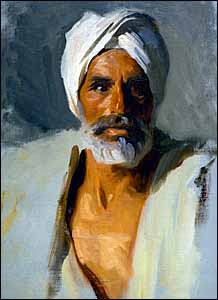 Here's my mental image of what Nehemiah must have looked like. John Singer Sargent, 'Head of an Arab' (1891), oil on canvas, 31.5 x 23.12 inches, Museum of Fine Arts, Boston. |
As mentioned in the preface, Old Testament history clusters around two "watersheds," the Exodus from Egypt and the Exile to Babylon.
All five of the books we are studying were written in Judah during what is known as the Post-Exilic Period, that is, the hundred years or so that follows the return from exile in Babylon that began about 537 BC.
If you're just getting familiar with the Old Testament, here's a quick glance at where these books fit:
- Patriarchs (1800-1500 BC) -- Abraham, Isaac, and Jacob
- Exodus (1400 BC) -- Moses
- Conquest and Judges (1400-950 BC) -- Joshua, Gideon, etc.
- Monarchy (950 to 587 BC) -- Saul, David, Solomon, and the Divided Kingdom
- Exile (604 to 537 BC) -- the Jewish community lives in Babylon
- Post-Exilic Period (537 to 430 BC) -- rebuilding the temple and walls of Jerusalem. Malachi, last book of the Old Testament, written about 430 BC.
- Intertestamental Period (430 BC to 6 BC) -- Greeks desecrate temple, Maccabee Rebellion, Hasmonean Dynasty, Romans conquer, Herod the Great.
- Life of Jesus of Nazareth (6 BC to 27 AD)
- The Early Church (27 AD to 95 AD). Last books of New Testament written about 95 AD.
Overview of Post-Exilic Books
We're studying five books in this series -- Ezra, Nehemiah, Haggai, Zechariah, and Malachi. Here's a quick overview so you can see where we're going. Instead of progressing in order of the books as they appear in the Bible, I've arranged the lessons in approximate chronological order. Here's what we'll cover in the 10 lessons.
- Returning to Rebuild the Temple (Ezra 1-6). This historical passage covers the period from Cyrus's proclamation, and includes the return of the first group from Babylon about 537 BC, the rebuilding of the temple, work stoppages due to enemies, and the completion and dedication of the temple about 515 BC.
- Realigning Priorities (Haggai 1-2). This is a short prophetic book of four prophecies given about 520 BC designed to encourage the Jewish leaders to get started again on rebuilding the temple.
- Encouragement for the Builders (Zechariah 1-6). Zechariah is a longer prophetic book that I've broken up into two lessons. The first lesson contains prophecies given about 520 BC designed to encourage the Jews to complete the temple project. Zechariah's prophecies come with some rather bizarre images to interpret.
- Prophecies of the Messiah (Zechariah 7-14). The second half of Zechariah contains four prophecies without a specific date. These point to the coming Messiah, a call to righteousness, an indictment of false shepherds, the final battle, and the New Jerusalem.
- Confession and Repentance (Ezra 7-10). After studying the prophecies leading up to the completion of the temple, we return to Ezra's narrative. Ezra leads a new caravan of Jews from Babylon to Jerusalem about 458 BC. Then we see how Ezra deals with the people's sins of intermarrying with non-believers.
- Nehemiah's Prayer (Nehemiah 1:1-2:8). Nehemiah hears of the plight of Jerusalem and offers a prayer to God that can serve as a model for us of a prayer of confession and intercession. We see a tough, spiritual leader in action.
- Restoring the Wall (Nehemiah 2:9-7:73). Jerusalem's wall has been broken down. Nehemiah organizes resources and teams, then completes the task in 52 days -- all amidst stiff opposition from Judah's enemies. But Nehemiah has to deal with intermarriage with non-Jews -- again.
- Repentance and Revival (Nehemiah 8-13). Now Ezra takes center stage again by reading and explaining God's law to the entire nation. The result is a genuine spiritual revival, and a final celebration of the completion of the wall.
- Love, Worship, and Marriage (Malachi 1-2). Now we move to the Prophet Malachi, who writes sometime between 460 and 430 BC. His first three prophecies concern the need for sincere worship, and faithfulness to a covenant of marriage, rather than easy divorces.
- Justice, Tithing, Purifying, and Judgment (Malachi 3-4). We conclude with Malachi's last three prophecies concerning purifying God's people, faithfulness in tithing, and the future Day of Judgment when the wicked are punished and the righteous vindicated. A final promise looks forward to John the Baptist and Jesus the Messiah.
A Quick Guide to the Exiles of Israel and Judah
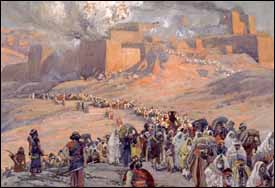 James J. Tissot, 'The Flight of the Prisoners' (1898-1902), gouache on board, The Jewish Museum, New York. |
The super-powers that conquered Israel and Judah -- both the Assyrians and the Babylonians -- responded to rebellious kings by destroying their cities and deporting thousands of their leaders and leading families to other places in the empire, leaving the local populations poor and leaderless. Let's look at these exiles.
Assyrian Captivity (began 740 to 722 BC). Assyria conquers many cities in both Judah and Israel, though not Jerusalem. They begin to deport people from the Northern Kingdom of Israel into exile about 740 BC (1 Chronicles 5:26; 2 Kings 15:29). When Samaria the capital falls after a three-year siege, thousands more are deported (2 Kings 17:3-6; 18:11-12). Most of these exiled Jews assimilate into the peoples of the lands where they are taken, and never return in any large numbers. The Assyrians go a step further and bring displaced peoples from other regions to settle in Israel. Those Israelites that remain retain a kind of Yahweh worship that mixes with worship of pagan gods of the land and of the displaced persons brought by the Assyrians. This group is known as the Samaritans, and opposed the Jews who return from exile from Babylon. They were still rejected by the Jews in Jesus' day.
Babylonian Captivity (began 604-587 BC). The Babylonians, who succeed the Assyrians as a superpower, conquer rebellious Judah and seek to subdue it by three deportations in 604 BC, 597 BC, and finally in 587 BC, when Jerusalem is destroyed and all the leaders exiled, leaving only the poorest in the land. The Jewish faith, however, experiences a renewal while in exile, a return to observance of the Mosaic Law. Though many Jews eventually prosper in Babylon and have no desire to return, many long to return to Jerusalem and rebuild their temple, the center of their faith and the locus of the sacrificial system that remits their sins.
Rise of the Medo-Persian Empire
Cyrus, King of Persia (Cyrus II to historians), is known as Cyrus the Great because he is the founder of the Achaemenid Empire. In 559 BC, he receives from his father reign over the minor Persian kingdom of Anshan, in what is now southwest Iran. Cyrus is ambitious. His kingdom is a vassal of the overlord Astyages who rules the vast Median empire. But Cyrus rebels. By 550 BC he has captured the capital at Ectabana and overthrown Astyages, taking control of all the vassal kingdoms of the Medes, uniting them with the Persian kingdoms, and forging the great Medo-Persian empire that lasts for more than 200 years. Next, he turns his attention to putting down a rebellion in Assyria. Finally, he turns to Babylon. (For more details see Appendix 4. The Medo-Persian Empire.)
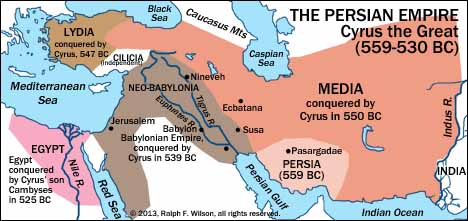 The Persian Empire under Cyrus the Great (Larger map) |
The Fall of Babylon
Babylon is ruled by Nabonidus (556--539 BC). He isn't much interested in governing or commanding the army. Instead, he spends years at a time away from the capital city pursuing his hobbies. He leaves his son Belshazzar to command the army and rule in Babylon as co-regent. The Babylonian Empire, strong under Nebuchadnezzar, is now growing old and weak.
Moreover, there are rumors of the rising power of the neighboring Medo-Persians, united 549 to 546 BC under Cyrus the Great (559--530 BC). After putting down a rebellion in Assyria, Cyrus now turns his attentions to the once-great Babylonian Empire.
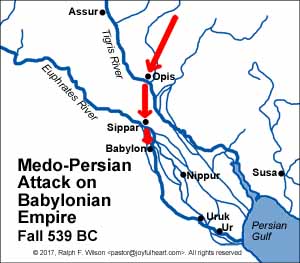 Medo-Persian Attack on the Babylonian Empire, Fall 539 BC (larger map) |
In October, 539 BC, a great battle occurs at Opis, a regional capital located at a crossing of the Tigris river, 47 miles (76 km.) north of the city of Babylon. The Babylonian army is attacked by Cyrus's Medo-Persian army of overwhelming numbers, delivering the Babylonians a crushing defeat. Almost immediately, the nearby city of Sippar -- less than 40 miles (about 60 km.) north of Babylon -- surrenders. And in a short period of time, the Medo-Persian army is at the gates of Babylon.
Though accounts differ, it seems that Babylon fell to the Medo-Persians without a fight.[1] Daniel's account of the handwriting on the wall of the royal palace describes the swiftness of Babylon's fall. Daniel the Prophet is summoned to interpret the cryptic words on the wall. He declares
"This is what these words mean:
Mene: God has numbered the days of your reign and brought it to an end.
Tekel: You have been weighed on the scales and found wanting.
Peres: Your kingdom is divided and given
to the Medes and Persians."
(Daniel 5:26-28)
God's execution of this sentence is swift:
"That very night Belshazzar, king of the Babylonians, was slain, and Darius the Mede took over the kingdom, at the age of sixty-two." (Daniel 5:30-31)
Overnight, the vast Babylonian Empire is under the control of Cyrus the Great -- and things change rapidly for the Jewish exiles.
The Province of Judah (Yehud)
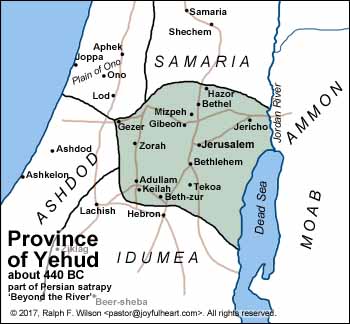 The Persian Province of Yehud (Judah), about 440 BC (larger map) |
A remnant of the Jewish community in Babylon returns in several migrations, beginning about 537 BC (Ezra 1-6) led by Zerubbabel (grandson of Jehoiachin, a former king of Judah) and Jeshua, the high priest. We're told that another company comes with Ezra about 458 BC (Ezra 7-8).
After building homes in various towns in Judah, the Jews seek to rebuild the temple in Jerusalem. Due to opposition from the surrounding provinces -- the Amorites, the Samaritans, and the Arabs -- they are hindered and finally have to stop. God sends two prophets about 520 BC -- Haggai and Zechariah -- who inspire the people to complete the temple about 515 BC.
Rebuilding the Walls under Nehemiah
However, Jerusalem's walls are still broken down, making the city defenseless. Any attempts to restore the walls are met by sharp opposition from enemies that obtain restraining orders from various kings of Persia -- including Artaxerxes (464-424 BC). But Nehemiah is cupbearer to Artaxerxes, who appoints him to be governor of Judah and complete the walls -- trumping previous anti-Jewish policies (445 BC). After developing building teams and assembling the needed materials, Nehemiah leads them to complete the walls in 52 days and later leads in a great celebration as the Jews march around the city on the top of the newly repaired walls.
 Available in paperback, PDF, Kindle formats |
Revival
While Nehemiah is primarily the civil governor during this time, Ezra, a priest and scribe, is the spiritual leader. By means of a Scripture-reading marathon, the people's hearts are touched, and they begin to repent of sins and pledge themselves to serve God faithfully.
Later, however, we see signs of the revival waning. Like Ezra before him, Nehemiah has to deal with the vexing problem of intermarriage with the surrounding non-Jewish people that directly affect the integrity of the Jewish people. Sometime in this period God sends the Prophet Malachi to challenge the people's complacency and spiritual drifting. Malachi is the last Old Testament book to be written, perhaps as late as 430 BC, and closes the Post-Exilic Period that we are studying.
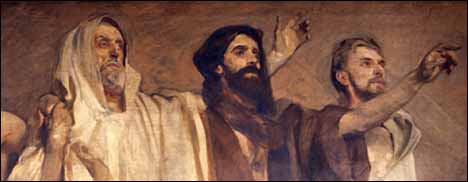 John Singer Sargent, detail of 'The Triumph of Religion: Frieze of the Prophets' (installed 1895, East Wall), Boston Public Library. Left to right: Haggai, Malachi, and Zechariah. |
Endnote
[1] Both the Babylonian Chronicle and the Cyrus Cylinder describe Babylon being taken "without battle." The Greek historians Herodotus and Zenophon report a siege of the city. Daniel's account implies that Babylon was taken in one night.
Copyright © 2025, Ralph F. Wilson. <pastor![]() joyfulheart.com> All rights reserved. A single copy of this article is free. Do not put this on a website. See legal, copyright, and reprint information.
joyfulheart.com> All rights reserved. A single copy of this article is free. Do not put this on a website. See legal, copyright, and reprint information.
 |

|
In-depth Bible study books
You can purchase one of Dr. Wilson's complete Bible studies in PDF, Kindle, or paperback format -- currently 48 books in the JesusWalk Bible Study Series.
Old Testament
- Abraham, Faith of
- Jacob, Life of
- Moses the Reluctant Leader
- Joshua
- Gideon
- David, Life of
- Elijah
- Psalms
- Solomon
- Songs of Ascent (Psalms 120-134)
- Isaiah
- 28 Advent Scriptures (Messianic)
- Daniel
- Rebuild & Renew: Post-Exilic Books
Gospels
- Christmas Incarnation (Mt, Lk)
- Sermon on the Mount (Mt 5-7)
- Luke's Gospel
- John's Gospel
- Seven Last Words of Christ
- Parables
- Jesus and the Kingdom of God
- Resurrection and Easter Faith
- Apostle Peter
Acts
Pauline Epistles
- Romans 5-8 (Christ-Powered Life)
- 1 Corinthians
- 2 Corinthians
- Galatians
- Ephesians
- Philippians
- Colossians, Philemon
- 1 & 2 Thessalonians
- 1 &2 Timothy, Titus
General Epistles
Revelation
Topical

 To be notified about future articles, stories, and Bible studies, why don't you subscribe to our free newsletter, The Joyful Heart, by placing your e-mail address in the box below. We respect your
To be notified about future articles, stories, and Bible studies, why don't you subscribe to our free newsletter, The Joyful Heart, by placing your e-mail address in the box below. We respect your